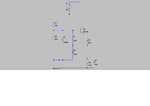Wajx93
Newbie level 2
Hi,I would like to find out the values of Cs,Cp,Ls and Rs of the crystal for creating oscillations of 28Mhz. my circuit is:

this only forms my first stage and the BF199 is important as i need to go on to make a 2W 85Mhz transmitter.
i have tried few values but the oscillations just won't start.
any suggestions?
plz help.

this only forms my first stage and the BF199 is important as i need to go on to make a 2W 85Mhz transmitter.
i have tried few values but the oscillations just won't start.
any suggestions?
plz help.